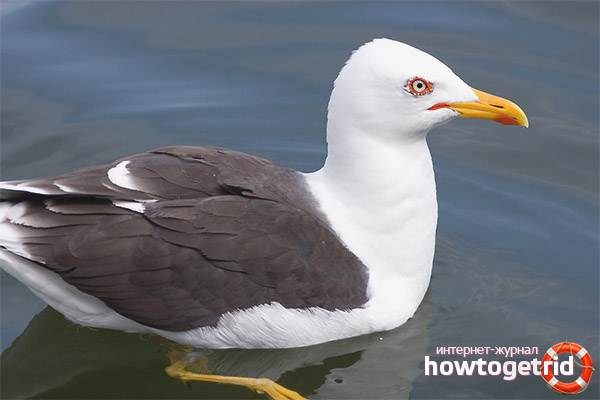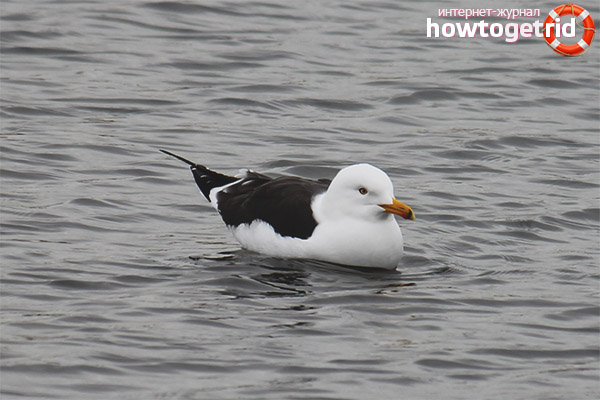The content of the article
Klush are understood as individuals who, by their external data, are similar to gulls. These birds prefer to live on the Atlantic coast, as well as in the north of our country. If we compare the klush and her closest relative, the gull is silver, then the first type is smaller, slim and dark in terms of color.
Description
- If we compare the individuals of this pedigree group with their brethren, then we can say that the whales belong to large-sized birds. They grow up to 55 cm across the hull. According to the wingspan, the indicators range from 110-130 cm, which is pretty good for this breed, taking into account a weight of 1 kg.
- The abdominal region is painted in a whitish hue, as well as the area of the neck, tail, head. The back is pigmented dark, namely brown or gray. Feathers of the same shade can play with colors, alternating with light brown or light gray.
- The klush has a yellowish bright beak. It is compressed from the side parts, but its shape is straight, except that the tip is directed downward. In the area of the bend, a red mark can be seen. Iris yellowish, light. There are no feathers in the area around the orbits, so red skin is visible.
- A distinctive feature is the color of the legs, namely yellow with orange pigment. It is by this criterion that we can distinguish individuals of this breed group from sea gulls. For comparison, the last legs are painted either in a delicate yellow or pinkish tone.
- Young animals can be distinguished from mature individuals not only by behavior, but also by external data. For example, the younger generation is similar to silver gulls. That is, the color is colorful, on the plumage there is an alternation of light and dark tones. You can find ocher shades and other elements from this category (brownish, light gray).
- In young individuals, the irises are not yellow, but brownish. The beak is black. When young growth reaches the age of 1 year and older, its back acquires a gray tone, a little dimmer than that of older birds. The head, abdominal part, neck also become light. But these parts are still mottled, they will soon acquire a whitish color characteristic of the species. Closer to the third year of life, young areas disappear in dark areas, brownish feathers remain at the end of the tail and in the neck area.
- A distinctive feature of these birds is the size of the wings, which allows the birds to fly quickly and beautifully. They can hang in the air for a long time, and also overcome decent distances. Most often, these individuals are found in the open sea, they accompany the ship.
Varieties
- Today we are considering the main representative of the species - common whale. But few people know that there are other varieties. A similar representative of the family is considered a Harley bird, or eastern klusha.
- It is distinguished by large dimensions, a rounded head, as well as elongated legs and a powerful beak. In the body, individuals grow up to 70 cm. With a weight of up to 1.5 kg. and a wingspan of about 150 cm. Agree, it’s impressive, provided that Harley and the common klush are representatives of the same family.
- The eastern inhabitants have a grayish plumage with dark spots on the wings and back. In winter, individuals are painted with brown stripes of small type in the neck and head. The paws are yellowish, but sometimes you can find birds with pink legs.
- A distinctive feature of this variety is considered to be a late moult. The bird looks like it has an old plumage in its head area, which is subsequently replaced with a large delay by a new plumage. The same can be said of wings.
- In some sources, this species of klush is called the Taimyr gull. Representatives of the family are common in the northern part, as well as in eastern Russia. Individuals can be found in Finland. For wintering, birds fly to the east of Africa, west or south of Asia.
Food
- Since these birds are still marine, their nutrition is appropriate. They eat fish and other marine life. Also feed on worms, small rodents, insects.
- There were situations when, from starvation, Kloshi destroyed the nests of their associates. When on the ground they eat seeds, roots, fruits. People working on the ship claim to often see this breed next to the ship.
- These birds are distinguished by high intelligence and cunning. They hover in the sky for a long time, looking for prey, and then quickly sink down. Beautiful dives come out of the klush.
Habitat
- In general, the considered individuals live on the northern and western coasts of the European continent. In addition, the presented birds are found on Russian territory. Individuals are often found in the western part of the Taimyr Peninsula.
- Almost all species of individuals represented are migratory birds. Living most of the time in eastern and northern Europe, birds begin to migrate to a distance of 8000 km. Often birds fly to Africa.
- Often, migratory birds can be found in the Mediterranean, basins of the Caspian and Black Seas. Also, individuals often winter in the Persian Gulf and the Red Sea. Some individuals living in Scandinavia and Western Europe often migrate to the southwest.
- On this side you can find the northwestern coast of Africa and the Iberian Peninsula. The majority of individuals living in Siberia are sent for wintering to India, Pakistan and the Middle East. In rare cases, such birds have been seen on eastern North American shores.
- Often, nesting of the considered individuals occurs on the rocky seashores. Also, the coasts of large lakes and, in rare cases, moorlands, which are located near the water, are chosen as places for breeding kloshi. It is believed that such individuals are very fond of the island.
Breeding
- It is worth noting that the considered representatives of the birds are monogamous. During the mating season, individuals are paired and fly to nesting sites. Mating time is in the spring. Birds can fly to warm areas at different times due to the climatic conditions in which they live.
- Therefore, nesting can begin from mid to late spring. Before breeding, clams have mating games. The individuals begin to cry out loudly. At the same time, they either lower or throw their head back. Individuals bend in every way and treat each other with food.
- This behavior of klush during mating time is very similar to the game of silver gulls. Represented individuals often nest in small colonies or in pairs. Families can count from 10 to 20 individuals.
Interesting Facts
- The closest relatives of the considered individuals are silver gulls. Such birds often live in the same places. Here are just the gulls are stronger and larger, so often drive the claus from their territory.
- It is worth noting that the urge and voice of the individuals represented are rather low and rude. In case of danger and during anxiety, they emit characteristic sounds “ha-ha-ha”.
The individuals of the presented breed group differ from all the others in their appearance and beauty of flight. The birds have long enough wings that allow you to literally soar through the air.
Video: Klusha (Larus fuscus)












Submit